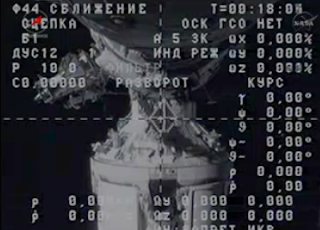Now arriving: HTV-3 from Japan.
The astronauts make it all seem so easy... but they've had a very busy schedule lately. The Japanese automated cargo spacecraft HTV-3 which blasted off on July 21, arrived at the station on July 27 and carefully approached its docking port. Using the robotic arm, astronauts Aki Hoshide and Joe Acaba captured the craft and guided it in to a perfect docking. The HTV-3, nicknamed "White Stork", carries about 4 tons of supplies for the station and crew of Expedition 32. Included in the equipment were a number of small "cubesats" which will be released from the station to perform experiments in orbit.
Using the robotic arm to grab the spacecraft.
Woops! Suddenly night time, but the cameras can still image the docking.
After securing HTV-3, there was another docking to complete. You may remember that the Russian Progress TMA-05M cargo spacecraft had undocked from the station to perform some docking tests, only to be postponed due to some glitch. Well, it turns out that there had been an overheating problem in some of the docking and rendezvous computers and the ground controllers (no one on board the robotic spacecraft) decided it was better to wait for the finish of HTV-3 docking before resuming the tests.
Russian Progress camera view during the undocking.
On Saturday July28, ground controllers successfully re-docked the Progress with the station on the PIRS module. Everything seems to have gone well on this second try. The new Kurs NA docking antenna was used for this procedure. The new system combines all the work previously done with the Kurs A system, so that transmissions using 5 different antennas are combined into the new, one antenna. There was no rick to the cargo on the Progress, as its cargo had already been unloaded during the last three months, and the craft was now filled with garbage.
With the docking tests completed, on Monday the Progress was once again undocked, this time never to return. Ground controllers and engineers will conduct several engineering tests with the Progress in orbit, before it is finally given commands to re-enter the atmosphere and burn up over the ocean.
But wait... Here comes another one!
A previous Progress on final approach.
Russian space engineers scored a new success in the Progress Program. On Wednesday, the Progress 48 spacecraft blasted off from Baikonur on a test of a new trajectory approach to the ISS. Although NASA had been doing same-day rendezvous and dockings since the Gemini program, the Progress and Soyuz rockets had used a traditional 2-day orbital chase to the station. As you've seen the inside of a Soyuz capsule, there isn't much room for the passengers, and they no doubt suffer some amount of stress during the 2-day flight to the station. However, new equipment advances and a new all-digital rocket control system has allowed a better opportunity to use the new fast-rendezvous profile.
Progress 48.
The new fast-rendezvous profile launch allows the spacecraft to make additional braking rocket burns to match orbits with the ISS. The ISS itself is boosted into a more docking-useful orbit which allows a fast-rendezvous launch every three days. With this new launch profile, the spacecraft can reach the ISS in about 4 orbits or six hours. This Progress launch was a test of the new procedures. After further tests are completed, it is expected that the new launch profile will be used for Soyuz flights as well. This will be great for passengers, as any astronauts having trouble adapting to weightlessness (space adaptation syndrome) will have an easier time getting to the station earlier and entering the vast interior of the station.
The new Progress brings up almost 3 tons of supplies and is docked at the PIRS module.







No comments:
Post a Comment